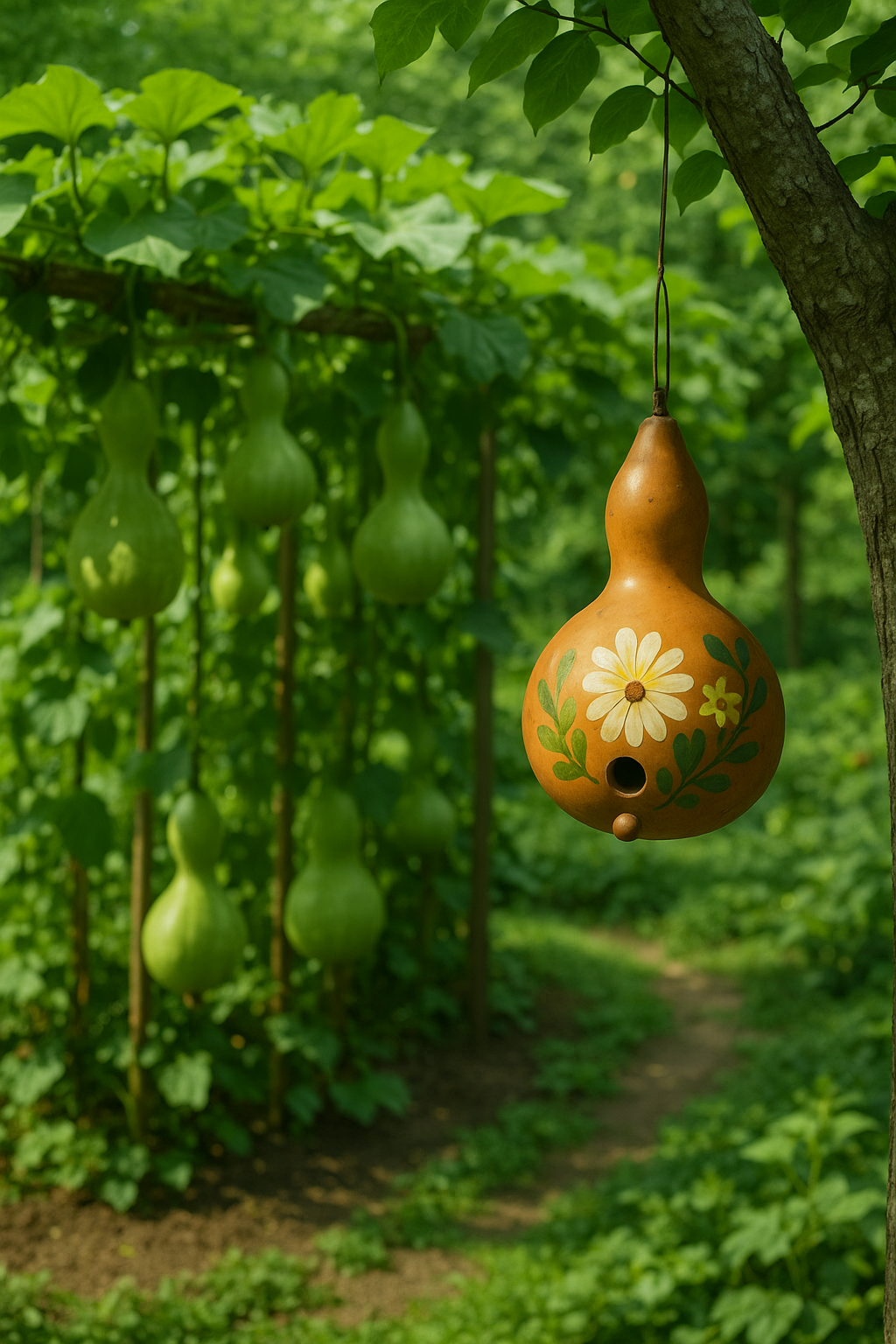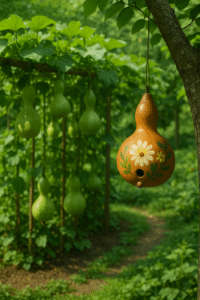How to Grow Gourds for Birdhouses: A Complete Gardener’s Guide

There is a unique and deeply satisfying connection that comes from providing a home for wild birds. But to take that connection a step further—to cultivate that home from a single, tiny seed—is one of the most rewarding projects a gardener and nature lover can undertake. Growing your own birdhouse gourds is a journey that immerses you in the full cycle of nature, a slow and deliberate process that begins with spring soil and ends with a durable, all-natural birdhouse that can last for decades.
My own journey with gourds began with a gift: a handful of rattling, dried seeds from a neighbor’s massive harvest. I had no idea what I was doing. I tossed them in the ground, and by some miracle, a few sprouted. The vines grew with a ferocious intensity I’d never seen, swallowing a section of my fence and producing a dozen pale green, alien-looking fruits. That first year was one of learning—of fighting squash bugs, of wondering why so few of the flowers turned into gourds, and of the almost mystical, months-long process of curing them in my garage. But the moment I drilled that first entrance hole and hung that finished gourd, I was hooked. I wasn’t just a gardener anymore; I was a habitat creator.
This guide is the culmination of everything I’ve learned since that first experimental season. We will go step-by-step through the entire, year-long process, from selecting the right seeds to hanging the finished, bird-ready home. This is more than a gardening tutorial; it’s a blueprint for creating a legacy in your backyard.
The Gourd Growing Process: A Bird’s Eye View
Growing a birdhouse gourd is a year-long project. Here is the entire journey, from seed to sanctuary.
- Choose the Right Seeds: Select a hardshell gourd (Lagenaria siceraria) variety like “Birdhouse” or “Bottle” gourds.
- Start Seeds Indoors: Start seeds in pots 4-6 weeks before your last frost date to give them a head start.
- Build a Strong Trellis: Gourds are heavy. A sturdy trellis, arbor, or fence is essential for them to climb.
- Plant in Full Sun: Gourds need at least 6-8 hours of direct sunlight and rich, well-drained soil.
- Water and Feed: Provide consistent water, especially during fruit development, and feed with a balanced fertilizer.
- Harvest at the Right Time: Wait until late fall when the vine and stem are dry before harvesting.
- Cure for Months: The most crucial step is to let the gourds dry in a well-ventilated area for 3-12 months until they are hard, light, and the seeds rattle inside.
- Craft Your Birdhouse: Clean the cured gourd and drill an entrance hole, drainage holes, and ventilation holes.
The Step-by-Step Guide to Growing Your Own Birdhouse
Step 1: Choosing Your Champion – Selecting the Right Gourd Seeds
Your journey begins with a choice. Not all gourds are created equal. The colorful, warty gourds you see in autumn displays are ornamental (Cucurbita pepo) and will rot. You need a hardshell gourd from the genus Lagenaria siceraria. These are the gourds that dry to a wood-like consistency.
Top Varieties for Birdhouses:
- “Birdhouse” or “Bottle” Gourds: This is the classic choice. They grow with a natural bulbous bottom and a thinner neck, the perfect shape for a nesting cavity.
- “Kettle” Gourds: These are large and round, like a pot, offering a spacious interior perfect for larger birds like Purple Martins or even small owls.
- “Dipper” Gourds: These have a long handle and a smaller ball at the end. While often used for crafts, the smaller varieties can be suitable for wrens.
When you’re ready to start, our guide to the best birdhouse gourds can give you an idea of the finished product you’re aiming for.

Start with Quality Seeds: Mountain Valley Birdhouse Gourd Seeds
Your success is directly tied to the quality of your seeds. I recommend starting with a trusted supplier that provides non-GMO, high-germination seeds. This packet from Mountain Valley Seed Company is an excellent choice. It contains plenty of seeds for a season’s worth of planting. Starting with a pure, reliable seed stock like this is the first and most important step to a bountiful harvest.
Check Price on AmazonStep 2: The Head Start – Germinating Your Seeds Indoors
Hardshell gourds have a very long growing season, often needing 120-180 days to mature. For most of the U.S., this means you need to start your seeds indoors, about 4-6 weeks before your last expected frost date, to give them enough time. Gourd seeds have a tough coat, and they need a little help to germinate.
- Scarify the Seeds: Use a nail file or a piece of sandpaper to gently scuff the edges of the seed coat. This allows water to penetrate more easily.
- Soak Overnight: Place the scuffed seeds in a bowl of warm water and let them soak for 12-24 hours.
- Plant in Peat Pots: Plant one seed per 3-4 inch pot, about an inch deep. I highly recommend using biodegradable peat pots. Gourd seedlings have sensitive roots and do not like to be disturbed, so you can plant this entire pot in the ground when it’s time to transplant.
- Keep Warm: Place the pots in a warm, sunny windowsill or, for best results, on a seedling heat mat. Keep the soil consistently moist but not waterlogged. You should see sprouts in 7-14 days.

For Guaranteed Germination: A Seedling Heat Mat
Gourd seeds, like many in the squash family, need warmth to sprout reliably. A seedling heat mat is a game-changer for getting a strong, uniform start. It gently warms the soil to the optimal temperature for germination, dramatically increasing your success rate. This VIVOSUN mat is durable, waterproof, and the perfect size for a tray of gourd seedlings. It’s a tool that serious gardeners use to take the guesswork out of starting seeds.
Check Price on AmazonStep 3: The Foundation – Preparing Your Garden and Trellis
While your seedlings are growing indoors, it’s time to prepare their future home. Gourds are heavy feeders and vigorous climbers. They need two things: rich soil and something strong to climb on.
The Soil:
Choose a location that gets at least 6-8 hours of direct sunlight per day. Work a generous amount of compost or aged manure into the soil. Gourds need nutrient-rich, well-draining soil to thrive. Create a small “hill” or mound for each plant, about a foot high and two feet across. This helps the soil warm up faster and improves drainage.
The Trellis:
Do not underestimate the weight of a gourd vine. A single vine laden with heavy, water-filled gourds can easily crush a flimsy tomato cage. My first year, a vine pulled a section of my wooden fence clean off its posts. You need something seriously strong.
Good options include a sturdy cattle panel arched between two T-posts, a well-built wooden arbor, or a chain-link fence. The trellis should be at least 6-8 feet tall. A strong vertical support is crucial because it keeps the gourds off the ground, which prevents rot and ensures they develop a nice, symmetrical shape.
Step 4: The Big Move – Transplanting and Ongoing Care
Once all danger of frost has passed and your seedlings have 2-3 true leaves, it’s time to move them outdoors. Harden them off for a week by placing them outside for a few hours each day, gradually increasing their exposure to sun and wind.
Plant one seedling per hill, burying the entire peat pot so the roots are not disturbed. Water them in well. Apply a thick layer of straw or wood chip mulch around the base of the plant to retain moisture and suppress weeds.
Gourds are thirsty plants, especially when they start setting fruit. Water them deeply once or twice a week, providing at least an inch of water. Once the vines begin to run, you can feed them with a balanced, all-purpose liquid fertilizer every 3-4 weeks.
Step 5: The Final Touches – Training, Pollination, and Pruning
As the vines grow, gently guide them towards your trellis. They will eventually find it and start climbing on their own. Gourds produce both male and female flowers. The female flowers have a tiny, immature gourd at their base. If you notice you’re getting lots of flowers but very few gourds, you may have a pollination problem. You can play the role of the bee by taking a small paintbrush, gathering yellow pollen from a male flower, and gently dusting it onto the stigma inside a female flower.
For larger, healthier gourds, you can prune the vine. Once you have 2-3 well-shaped gourds developing on a main vine, you can prune the fuzzy tip of that vine. This tells the plant to stop putting energy into vine growth and focus all its resources on the existing fruit.
The Journey’s End: From Curing to Crafting
The growing process is only half the journey. Once you harvest your mature gourds in the fall, the long curing process begins. This critical drying phase can take many months but is essential for creating a durable, woody shell. After they are fully cured—light, hard, and rattling with seeds—it’s time for the final, rewarding steps of crafting your birdhouse. This involves cleaning the mottled skin, drilling the entrance and drainage holes, and preparing it for hanging.
This entire post-harvest process is a detailed craft in itself. For an exhaustive, step-by-step guide on this crucial phase, please read our companion article: How to Dry Birdhouse Gourds.
Frequently Asked Questions (FAQ)
How many gourds will one plant produce?
This varies greatly by variety and growing conditions, but a healthy, well-pollinated plant can produce anywhere from 2 to 10 usable birdhouse gourds.
Can I grow gourds in a large pot or container?
Yes, but it needs to be a very large container—at least 20 gallons—with a built-in trellis. You will need to be extra diligent with watering and feeding, as container plants dry out and use up nutrients much faster.
What are the most common pests for gourds?
The most common are squash bugs and cucumber beetles. You can pick them off by hand or use a safe, organic insecticide like Neem oil. Powdery mildew, a white, dusty fungus on the leaves, is also common. You can treat this with a potassium bicarbonate spray or by ensuring good air circulation around the plant.
Do I have to hand-pollinate my gourds?
No, in most cases, local bees and other pollinators will do the job for you. However, if you live in an area with few pollinators or are having a hard time getting fruit to set, hand-pollination is a simple way to guarantee a harvest.
Conclusion: A Home Grown with Patience and Care
Growing a birdhouse from a seed is an act of profound optimism and patience. It’s a project that unfolds over a full year, mirroring the very cycles of life you hope to host within the finished product. From the tender care of a seedling to the long, quiet wait of the curing process, every step is a part of the story. When you finally hang that finished gourd, and a curious wren or a bold purple martin chooses to raise its family inside, the connection you feel will be unlike any other. You didn’t just provide a home; you grew one.

